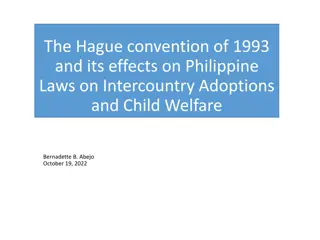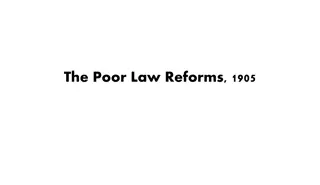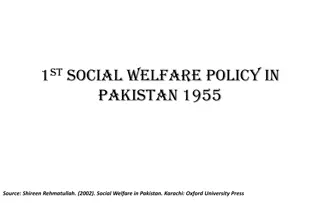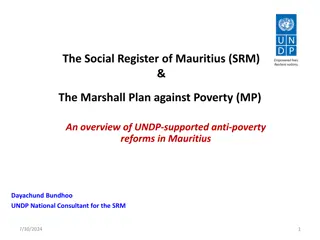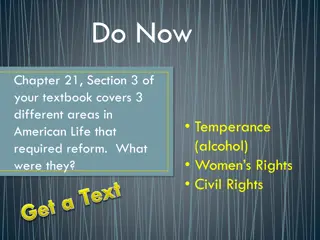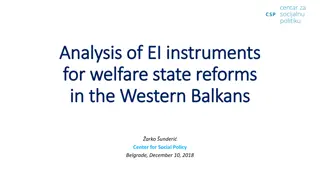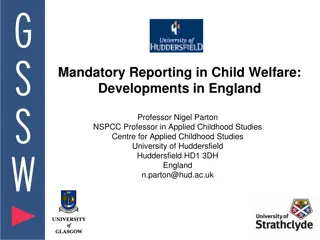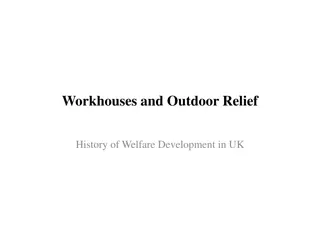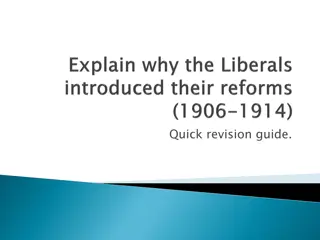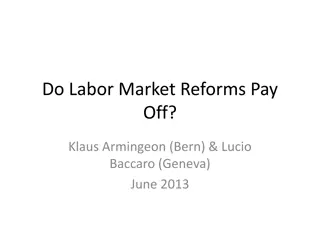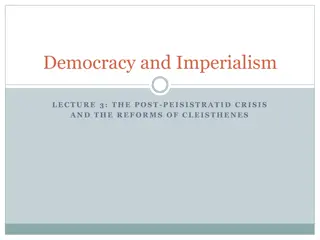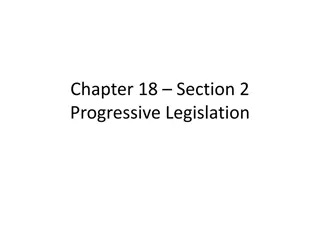History of Poor Laws Reforms in the UK (1905) - Development of Welfare
In 1905, the Liberal Party in the UK promised reforms for the poor laws and aid for the unemployed. A Royal Commission was appointed to address the distress caused by mass unemployment, with key figures like Beatrice Webb and Sidney Webb playing significant roles. This period marked a crucial turning point in the UK's welfare development, as the government grappled with the challenges posed by widespread unemployment and the need for social welfare provisions.
Download Presentation

Please find below an Image/Link to download the presentation.
The content on the website is provided AS IS for your information and personal use only. It may not be sold, licensed, or shared on other websites without obtaining consent from the author.If you encounter any issues during the download, it is possible that the publisher has removed the file from their server.
You are allowed to download the files provided on this website for personal or commercial use, subject to the condition that they are used lawfully. All files are the property of their respective owners.
The content on the website is provided AS IS for your information and personal use only. It may not be sold, licensed, or shared on other websites without obtaining consent from the author.
E N D
Presentation Transcript
Poor Laws Reforms 1905 History of Welfare Development in UK
At the beginning of England faced the grave threat of unemployment, especially in the coal mining regions. Because of the technical superiority of the United States mines and more favorable production and transportation conditions in the European coal industries, a British mines were forced to discontinue operations. Other needed fewer workers, and some closed because their coal supply was exhausted. As a result, masses of unemployed coal miners and their families asked for relief. the twentieth century, the people of number of
However, it was not possible to put entire communities into the workhouse, as required by the Poor Law of 1834. Some mining towns applied to Parliament for aid. Private charities found themselves unable to support tens of thousands of jobless families for unlimited periods, and national emergency funds had to be appropriated.
The Liberal Party in 1905 promised a reform of the poor laws and aid to the unemployed. A Royal Commission on the Poor Laws and Relief of Distress, with Lord George Hamilton as chairman, was appointed. Among its eighteen members was an aggressive minority composed of Mrs. Beatrice Webb (representing the Fabian Society), George Lansbury(Trade Unions and Labour Party), Francis Chandler (Trade Unions), and the Reverend Prebendary, later Bishop H. Russell Wakefield. In press discussions, the meetings of the Commission were cited as The Webbs against the Poor Law. Beatrice Web was morally supported by her husband, although he was not a member of the commission.
Sidney Webbs guardians, and his son inherited from him a concern for the fate of the workers and the poor. From the time he was sixteen years of age, Sidney Webb had worked for a living. He became an official with London City Council and accepted the role of economic analyst with the Fabian Society. His wife, Beatrice Potter Webb, came from a wealthy London business family. During the studies she became interested in economic and political theory. After serving for some time as a visitor for a district committee of the London Charity Organization Society and as a rent collector in a philanthropic housing project, she assisted Charles Booth in his study of the conditions of workers at the docks and in the sweat industries of London. father had served on one of the London boards of
In 1890 she undertook her own study of the cooperative movement and, during its preparations, met Sidney Webb, who advised her in this research. After the completion of the work they decided to study the trade union movement together. Beatrice Webb insisted, in the Royal Commission for a critical investigation of the poor law philosophy and its results. The extent of economic distress that the investigation revealed was appalling. The official statistics showed that 928,621 persons were receiving public relief, among them 300,000 children living under the most unfavorable conditions.
There were fundamental differences of opinion between the majority and minority of the commission. The majority wanted a mild reform of the old poor law and advocated close cooperation with private charities. The minority demanded the abolition of the poor law.
The Poor Law Commission did agree on the following recommendations. 1. Poor Law unions and boards of guardians should be replaced by county councils, reducing the number of local relief administrations by three quarters. 2. The punitive character of poor relief should be abolished in favor of a humane public assistance program. 3. Mixed almshouses should be abolished in hospitals: Mentally deficient and mentally ill patients should be treated in hospitals, and children placed in foster homes or residential schools. 4. National pensions for the aged, free hospital treatment for the poor gratuitous public employment services, and a program of social insurance with unemployment and invalidity benefits should be introduced.
As a result of the work of the commission the way for fundamental progress in social legislation was opened. Already during the sessions of the Royal Commission social legislation had started. The Provision of Meals Act of 1906 organized free school lunches in the elementary schools. The Education Act of 1907 provided medical examination for school children. The Old Age Pensions Act of 1908 secured a weekly pension of five shillings for deserving poor persons over seventy years of age.
Source: Book title Introduction to Social Welfare Authors: Walter A. Friedlander Robert Z. Apte







